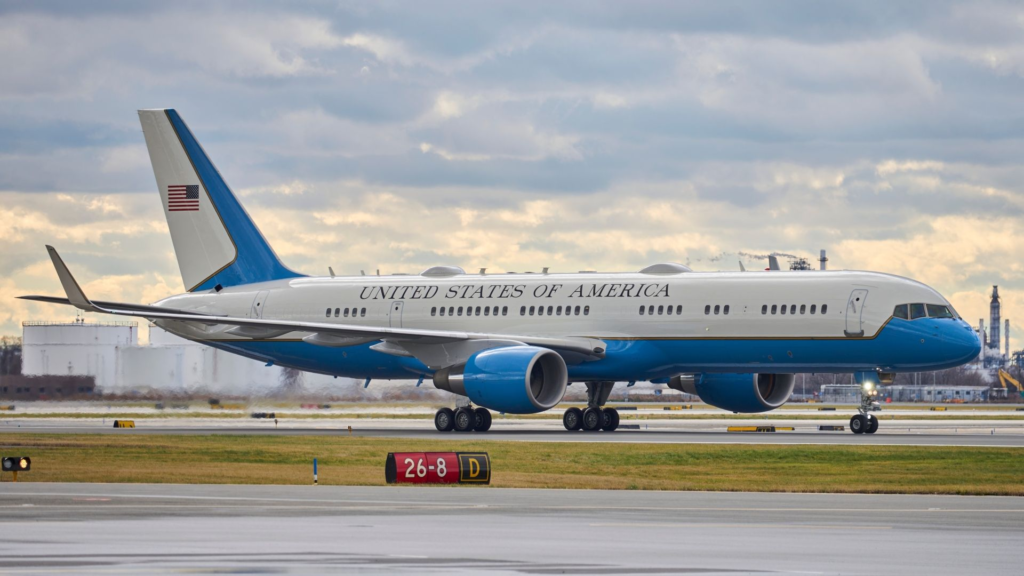A United States Air Force ![]() Boeing C-32A military transport aircraft carrying the American Secretary of Defense Pete Hegseth back from a NATO meeting in Belgium was forced to divert to the UK yesterday. The plane, which is a modified version of the 757-200, ended up landing at a military base in Suffolk after a cracked windshield prompted it to turn around while flying to the west, just beyond Ireland.
Boeing C-32A military transport aircraft carrying the American Secretary of Defense Pete Hegseth back from a NATO meeting in Belgium was forced to divert to the UK yesterday. The plane, which is a modified version of the 757-200, ended up landing at a military base in Suffolk after a cracked windshield prompted it to turn around while flying to the west, just beyond Ireland.
The jet, which issued the squawk code of 7700 to indicate the urgent nature of its diversion, also descended to a lower altitude, likely in order to avoid pressurization issues that may have occurred as a result of the incident. It landed safely yesterday evening, and remains on the ground in the UK.
Hegseth’s Unplanned UK Stopover
According to the BBC, Hegseth had been in Belgium for a NATO Defense Minister meeting, with tracking data from Flightradar24 showing that the Boeing C-32A, which bears the registration 98-0002, departed from Brussels Airport (BRU) at 16:50 local time. It did so under the callsign RCH153, which it had also used for its flight over to Brussels from Camp Springs (ADW), which it undertook on Tuesday night.
After taking off from Belgium’s busiest airport, the Boeing C-32A with Hegseth onboard flew westward over England and to the south of Ireland. However, just over an hour into its flight, it began to descend, eventually dropping to 10,000 feet, and turned around, as seen above. It then retraced its past eastward before turning northeast to divert to RAF Mildenhall. Pentagon spokesperson Sean Parnell said that:
“Hegseth’s plane made an unscheduled landing in the United Kingdom due to a crack in the aircraft windshield. The plane landed based on standard procedures, and everyone onboard, including Secretary Hegseth, is safe.”
The Aircraft Remains On The Ground At The Time Of Writing
The aircraft eventually touched down at RAF Mildenhall yesterday evening at 19:08 local time, after spending three hours and 18 minutes in the air on its failed attempt to return to the US. At the time of writing on Thursday morning, the aircraft was yet to have departed from its unplanned stopover in Suffolk, although whether this is due to the cracked windshield or crew duty hour limits remains to be seen.
Interestingly, The Independent notes that it is not standard practice for the Secretary of Defense to travel on board the Boeing C-32A. Indeed, these modified 757-200s are typically used by the Vice President, and bear the callsign ‘Air Force Two’ when transporting the second in command. Instead, the publication reports, Hegseth and his predecessors have more commonly used the Boeing E-4B ‘Nightwatch.’
The E-4B is a modified variant of the Boeing 747-200B, and serves as an Advanced Airborne Command Post (AACP) aircraft for the USAF. However, this widebody quadjet, nicknamed the ‘Doomsday’ plane, is not getting any younger, having first flown in 1973, so a replacement is being readied.
All About The Boeing C-32
According to current fleet data made available by ch-aviation, the United States Air Force currently has six C-32 series aircraft at its disposal, with these modified examples of the Boeing 757-200 being split between four units of the C-32A and two units of the C-32B. The latter, also known as the ‘Gatekeeper,’ is used for airlift purposes, with the two examples clocking in at an average age of 32.1 years old.
The C-32A, meanwhile, is designated as a VIP transport aircraft, hence its use by the Vice President and, yesterday, the Secretary of Defense. The four units of this particular variant that the United States Air Force currently has at its disposal are a little younger than their C-32 counterparts.
Indeed, 98-0002, the example that suffered a cracked windshield yesterday evening, is 27.5 years old, having first flown back in April of 1998. Its VIP seating configuration has space for just 55 guests onboard, with ch-aviation showing that this figure is split between two first class and 53 business class seats.





